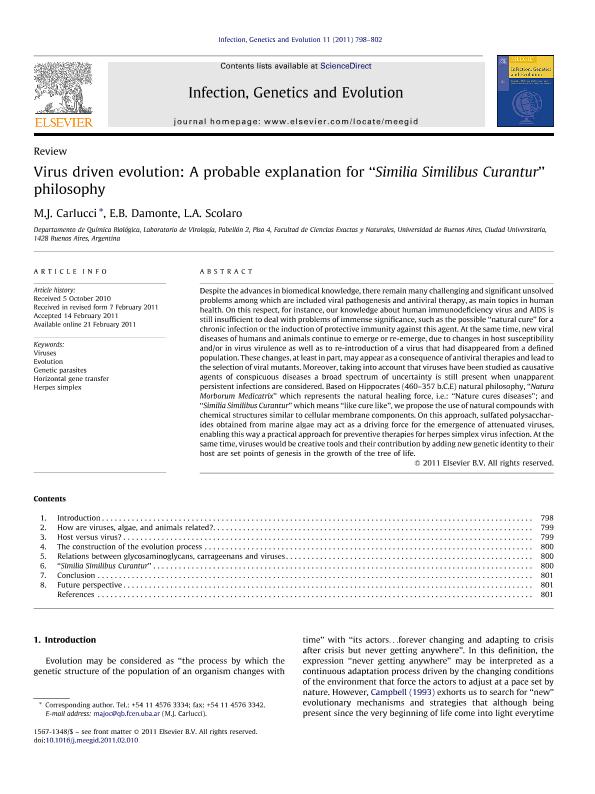Mostrar el registro sencillo del ítem
dc.contributor.author
Carlucci, Maria Josefina

dc.contributor.author
Damonte, Elsa Beatriz

dc.contributor.author
Scolaro, Luis Alberto

dc.date.available
2020-01-03T20:47:15Z
dc.date.issued
2011-07
dc.identifier.citation
Carlucci, Maria Josefina; Damonte, Elsa Beatriz; Scolaro, Luis Alberto; Virus driven evolution: A probable explanation for "Similia Similibus Curantur" philosophy; Elsevier Science; Infection, Genetics and Evolution; 11; 5; 7-2011; 798-802
dc.identifier.issn
1567-1348
dc.identifier.uri
http://hdl.handle.net/11336/93517
dc.description.abstract
Despite the advances in biomedical knowledge, there remain many challenging and significant unsolved problems among which are included viral pathogenesis and antiviral therapy, as main topics in human health. On this respect, for instance, our knowledge about human immunodeficiency virus and AIDS is still insufficient to deal with problems of immense significance, such as the possible " natural cure" for a chronic infection or the induction of protective immunity against this agent. At the same time, new viral diseases of humans and animals continue to emerge or re-emerge, due to changes in host susceptibility and/or in virus virulence as well as to re-introduction of a virus that had disappeared from a defined population. These changes, at least in part, may appear as a consequence of antiviral therapies and lead to the selection of viral mutants. Moreover, taking into account that viruses have been studied as causative agents of conspicuous diseases a broad spectrum of uncertainty is still present when unapparent persistent infections are considered. Based on Hippocrates (460-357 b.C.E) natural philosophy, " Natura Morborum Medicatrix" which represents the natural healing force, i.e.: " Nature cures diseases" ; and " Similia Similibus Curantur" which means " like cure like" , we propose the use of natural compounds with chemical structures similar to cellular membrane components. On this approach, sulfated polysaccharides obtained from marine algae may act as a driving force for the emergence of attenuated viruses, enabling this way a practical approach for preventive therapies for herpes simplex virus infection. At the same time, viruses would be creative tools and their contribution by adding new genetic identity to their host are set points of genesis in the growth of the tree of life.
dc.format
application/pdf
dc.language.iso
eng
dc.publisher
Elsevier Science

dc.rights
info:eu-repo/semantics/openAccess
dc.rights.uri
https://creativecommons.org/licenses/by-nc-sa/2.5/ar/
dc.subject
EVOLUTION
dc.subject
GENETIC PARASITES
dc.subject
HERPES SIMPLEX
dc.subject
HORIZONTAL GENE TRANSFER
dc.subject
VIRUSES
dc.subject.classification
Virología

dc.subject.classification
Ciencias Biológicas

dc.subject.classification
CIENCIAS NATURALES Y EXACTAS

dc.title
Virus driven evolution: A probable explanation for "Similia Similibus Curantur" philosophy
dc.type
info:eu-repo/semantics/article
dc.type
info:ar-repo/semantics/artículo
dc.type
info:eu-repo/semantics/publishedVersion
dc.date.updated
2019-11-08T15:07:57Z
dc.journal.volume
11
dc.journal.number
5
dc.journal.pagination
798-802
dc.journal.pais
Países Bajos

dc.journal.ciudad
Amsterdam
dc.description.fil
Fil: Carlucci, Maria Josefina. Universidad de Buenos Aires. Facultad de Ciencias Exactas y Naturales. Departamento de Química Biológica; Argentina. Consejo Nacional de Investigaciones Científicas y Técnicas; Argentina
dc.description.fil
Fil: Damonte, Elsa Beatriz. Universidad de Buenos Aires. Facultad de Ciencias Exactas y Naturales. Departamento de Química Biológica; Argentina. Consejo Nacional de Investigaciones Científicas y Técnicas; Argentina
dc.description.fil
Fil: Scolaro, Luis Alberto. Universidad de Buenos Aires. Facultad de Ciencias Exactas y Naturales. Departamento de Química Biológica; Argentina. Consejo Nacional de Investigaciones Científicas y Técnicas; Argentina
dc.journal.title
Infection, Genetics and Evolution

dc.relation.alternativeid
info:eu-repo/semantics/altIdentifier/doi/http://dx.doi.org/10.1016/j.meegid.2011.02.010
dc.relation.alternativeid
info:eu-repo/semantics/altIdentifier/url/https://www.sciencedirect.com/science/article/pii/S1567134811000529
Archivos asociados
